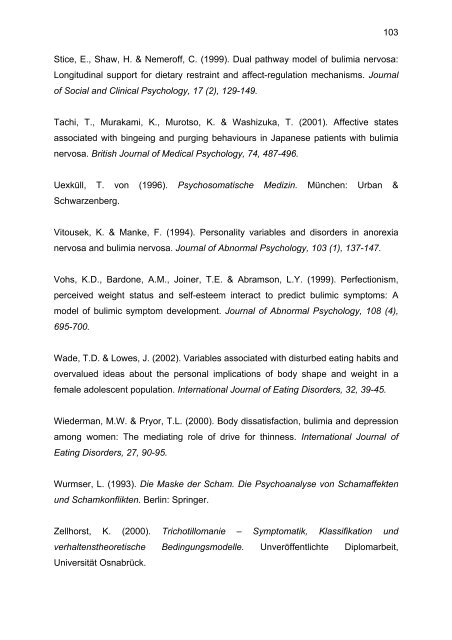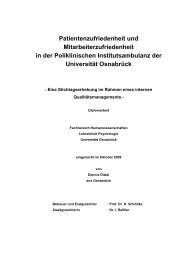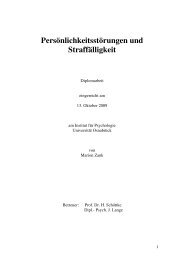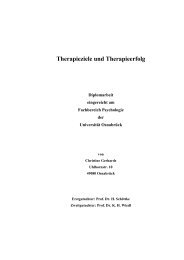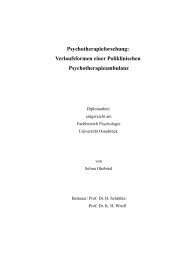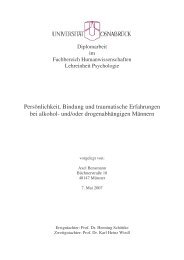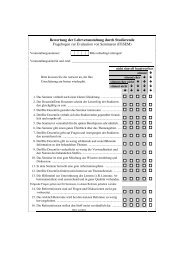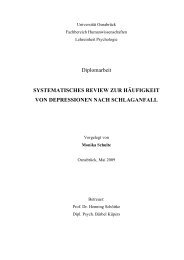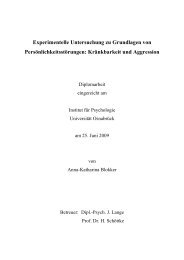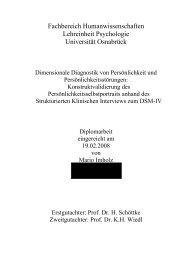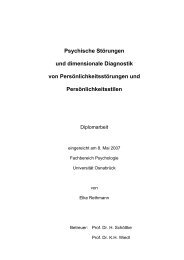Affektregulation bei Bulimia Nervosa - Universität Osnabrück
Affektregulation bei Bulimia Nervosa - Universität Osnabrück
Affektregulation bei Bulimia Nervosa - Universität Osnabrück
Sie wollen auch ein ePaper? Erhöhen Sie die Reichweite Ihrer Titel.
YUMPU macht aus Druck-PDFs automatisch weboptimierte ePaper, die Google liebt.
103<br />
Stice, E., Shaw, H. & Nemeroff, C. (1999). Dual pathway model of bulimia nervosa:<br />
Longitudinal support for dietary restraint and affect-regulation mechanisms. Journal<br />
of Social and Clinical Psychology, 17 (2), 129-149.<br />
Tachi, T., Murakami, K., Murotso, K. & Washizuka, T. (2001). Affective states<br />
associated with bingeing and purging behaviours in Japanese patients with bulimia<br />
nervosa. British Journal of Medical Psychology, 74, 487-496.<br />
Uexküll, T. von (1996). Psychosomatische Medizin. München: Urban &<br />
Schwarzenberg.<br />
Vitousek, K. & Manke, F. (1994). Personality variables and disorders in anorexia<br />
nervosa and bulimia nervosa. Journal of Abnormal Psychology, 103 (1), 137-147.<br />
Vohs, K.D., Bardone, A.M., Joiner, T.E. & Abramson, L.Y. (1999). Perfectionism,<br />
perceived weight status and self-esteem interact to predict bulimic symptoms: A<br />
model of bulimic symptom development. Journal of Abnormal Psychology, 108 (4),<br />
695-700.<br />
Wade, T.D. & Lowes, J. (2002). Variables associated with disturbed eating habits and<br />
overvalued ideas about the personal implications of body shape and weight in a<br />
female adolescent population. International Journal of Eating Disorders, 32, 39-45.<br />
Wiederman, M.W. & Pryor, T.L. (2000). Body dissatisfaction, bulimia and depression<br />
among women: The mediating role of drive for thinness. International Journal of<br />
Eating Disorders, 27, 90-95.<br />
Wurmser, L. (1993). Die Maske der Scham. Die Psychoanalyse von Schamaffekten<br />
und Schamkonflikten. Berlin: Springer.<br />
Zellhorst, K. (2000). Trichotillomanie – Symptomatik, Klassifikation und<br />
verhaltenstheoretische Bedingungsmodelle. Unveröffentlichte Diplomar<strong>bei</strong>t,<br />
Universität Osnabrück.


